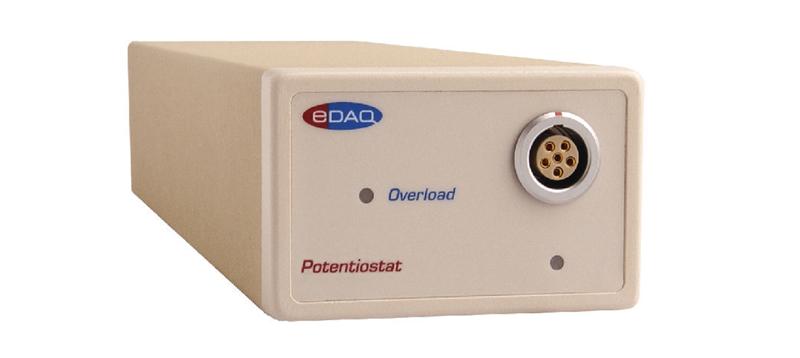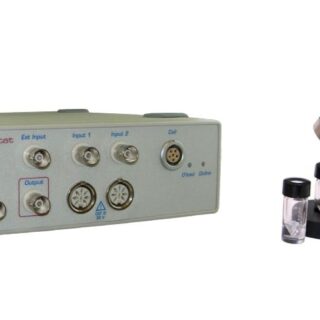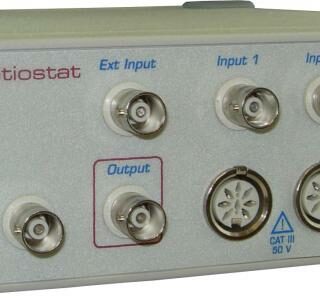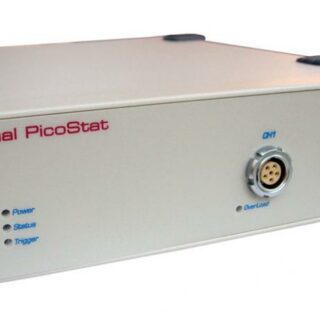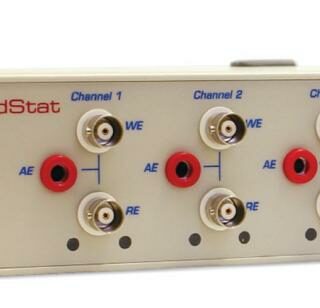Category
- Custom made glass products
- CUSTOMER SERVICES
- NEW PRODUCTS
- Sensors and electrodes
- Custom made and Modified Screen Printed Electrodes
- Stirrers
- Cables and connectors
- Cell
- Potentiostats
- Manual Screen Printer
- Minithermostat
- Pumps
- Accessories
- Kits & Sets
- Discounted SPEs (at a reduced price with visual defects/inconsistancies, but fully functional)
EA163 Potentiostat
- Modular potentiostat
- 4 modes: potentiostat, galvanostat, ammeter and voltmeter
This modular potentiostat is perfect for cyclic voltammetry and electroanalytical chemistry, and can use two (working and counter), or three (working, auxiliary and reference) electrodes. It can also operate as a galvanostat, ZRA (zero resistance ammeter), and high impedance voltmeter. It must be used together with any e-corder model.
The bandwidth of the EA163 is 100 kHz and so it is suitable for use with the Z100 Electrochemical Impedance Analyzer.
More information can be found through the link: https://www.edaq.com/EA163
Related products
-
ER461 EChem Startup System
Read moreMost popular eDAQ potentiostat
Potentiostat, galvanostat, ZRA and electrometer modes
Maximum 100 mA and ±10 VOpen your lab to the world of electrochemistry with the economically priced EChem Startup System. It has just about everything you need for most voltammetric experiments. The system is ideal for both research and teaching experiments, and especially for compound characterization with cyclic voltammetry.
More information can be found through the link: https://www.edaq.com/ER461
System Components:
• ER466 Integrated Potentiostat System
• ET014 EChem Electrode Kit
• ES260 EChem Software
• ES500 Chart and Scope SoftwareThe ER466 Integrated Potentiostat System is our most popular potentiostat model, being ideal for cyclic, linear sweep, and most analytical pulse voltammetric experiments, either in the research or teaching laboratory. It also functions as a galvanostat, ZRA (zero resistance ammeter), and high impedance voltmeter (electrometer). Connection to a computer is via a USB cable.
The EChem Electrode Kit contains gold, platinum and glassy carbon working disk electrodes. Reference and auxiliary electrodes are also included, together with two 3 mL reaction vials and a stand. The electrodes are suitable for use with the eDAQ potentiostats, and can be used in a variety of electrochemical applications.
Working electrodes, 1 mm disk, PEEK body:
ET074-1 Glassy carbon
ET075-1 Platinum
ET076-1 GoldReference electrode: ET072 Leakless Ag/AgCl
Auxiliary electrode: ET078-1 Pt coated titanium rod, 1.6 mm diameter
Two 3-mL reaction vessels with stirrer vane, drilled PTFE gasket and holder
Lead wire clampAvailable Techniques:
• Cyclic Voltammetry
• Linear Sweep Voltammetry *
• Square Wave Voltammetry *
• Normal Pulse Voltammetry *
• Differential Pulse Voltammetry *
• Multi Pulse Voltammetry
• Multi Pulse Amperometry
• Chronoamperometry (single or multistep)
• Chronocoulometry (single or multistep)
• Chronopotentiometry (single or multistep)
• Controlled potential electrolysis
• Controlled current electrolysis* Also available in stripping mode for trace element determination. Metals such as copper, lead, cadmium and zinc can be determined in the ppb range even in an undergraduate lab (no clean room required!).
Battery technology, corrosion science, conducting polymer and electrosynthesis experiments can also be performed. -
ER466 Integrated Potentiostat System
Read more- Ideal for cyclic voltammetry, linear sweep and pulse techniques
- Potentiostat, galvanostat, ammeter and voltmeter modes
- Maximum 100 mA and ±10 V
- Expandable using isoPod amplifiers
- High accuracy
- Windows 7, 8 and 10 compatible
The ER466 Integrated Potentiostat System is our most popular potentiostat model, being ideal for cyclic, linear sweep, and most analytical pulse voltammetric experiments, either in the research or teaching laboratory. It also functions as a galvanostat, ZRA (zero resistance ammeter), and high impedance voltmeter (electrometer). Connection to a computer is via a USB cable.
More information can be found through the link: https://www.edaq.com/ER466
-
EA362 Dual PicoStat
Read more- High sensitivity 2 channel potentiostat
- Bipotentiostat and 4-electrode modes of operation
The Dual PicoStat is a two channel high sensitivity potentiostat suitable for use with carbon fiber and ultramicroelectrodes for the monitoring of low current signals (down to picoameperes). It is commonly used for in vivo monitoring of dopamine by amperometry.
There are two potentiostat channels which enable the unit to also be used as a bipotentiostat (two working electrodes with a common reference and auxiliary electrode) so that dopamine levels can be monitored at two separate locations. Alternatively it can be used to perform duplicate experiments with separate samples, each with a working, reference and auxiliary electrode.
It can also be used as a 4-electrode voltage clamp (with two current passing and two voltage sensing reference electrodes) for studies of ionic transport across membranes or immiscible interfaces.
The Dual PicoStat is electrically isolated and is resistant to interference from neural stimulators, and ground loops. It is DC powered and can be used inside Faraday cages if required.
More information can be found through the link: https://www.edaq.com/EA362
-
EA164 QuadStat
Read more- Four-channel potentiostat 10mA to 200pA range
- Separate/common reference and auxiliary electrodes
- BiPotentiostat
- Ideal for amperometric biosensors, microbial fuel cells, photovoltaic materials and neurochemistry
The QuadStat is a software-controlled four-channel potentiostat with many Research Advantages (see below). Each channel can be used as a single three-electrode potentiostat. Alternatively two (bipotentiostat), three, or four working electrodes can be used in a single reaction chamber with a common reference and auxiliary electrode. Potential at each working electrode can be independently adjusted between ±2.5 V, or by using an external waveform generator to between ±10 V. The QuadStat can measure currents from pico- to milliamperes, making it ideal for amperometric biosensor research including use as a multichannel monitor for in vivo nitric oxide or dissolved oxgen sensors.
Two QuadStats can be ‘piggybacked’ to provide eight potentiostat channels.
By connecting the corresponding auxiliary and reference electrode leads, the QuadStat can be used as a four channel two-electrode (working and counter electrode) potentiostat. There is also a zero resistance ammeter (ZRA) mode of operation on each channel.
More information can be found through the link: https://www.edaq.com/EA164

